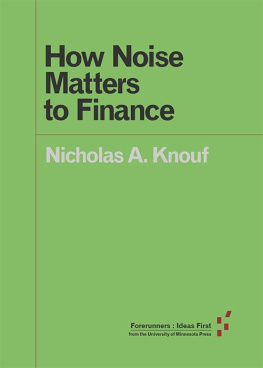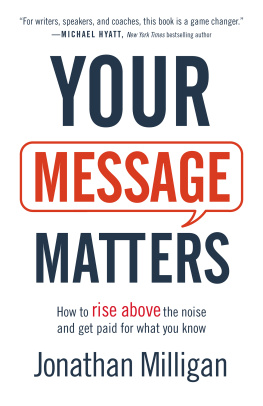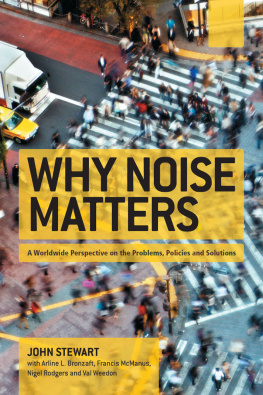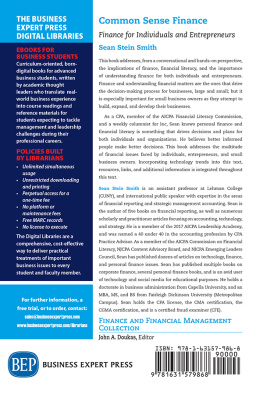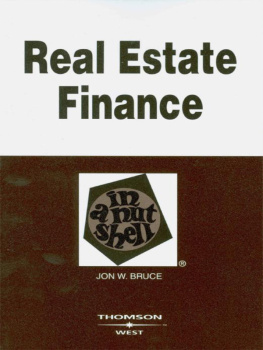Knouf - How Noise Matters to Finance
Here you can read online Knouf - How Noise Matters to Finance full text of the book (entire story) in english for free. Download pdf and epub, get meaning, cover and reviews about this ebook. year: 2016, publisher: University of Minnesota Press, genre: Romance novel. Description of the work, (preface) as well as reviews are available. Best literature library LitArk.com created for fans of good reading and offers a wide selection of genres:
Romance novel
Science fiction
Adventure
Detective
Science
History
Home and family
Prose
Art
Politics
Computer
Non-fiction
Religion
Business
Children
Humor
Choose a favorite category and find really read worthwhile books. Enjoy immersion in the world of imagination, feel the emotions of the characters or learn something new for yourself, make an fascinating discovery.
- Book:How Noise Matters to Finance
- Author:
- Publisher:University of Minnesota Press
- Genre:
- Year:2016
- Rating:4 / 5
- Favourites:Add to favourites
- Your mark:
- 80
- 1
- 2
- 3
- 4
- 5
How Noise Matters to Finance: summary, description and annotation
We offer to read an annotation, description, summary or preface (depends on what the author of the book "How Noise Matters to Finance" wrote himself). If you haven't found the necessary information about the book — write in the comments, we will try to find it.
Knouf: author's other books
Who wrote How Noise Matters to Finance? Find out the surname, the name of the author of the book and a list of all author's works by series.
How Noise Matters to Finance — read online for free the complete book (whole text) full work
Below is the text of the book, divided by pages. System saving the place of the last page read, allows you to conveniently read the book "How Noise Matters to Finance" online for free, without having to search again every time where you left off. Put a bookmark, and you can go to the page where you finished reading at any time.
Font size:
Interval:
Bookmark:
Forerunners: Ideas First from the University of Minnesota Press
Original e-works to spark new scholarship
F ORERUNNERS IS A thought-in-process series of breakthrough digital works. Written between fresh ideas and finished books, Forerunners draws on scholarly work initiated in notable blogs, social media, conference plenaries, journal articles, and the synergy of academic exchange. This is gray literature publishing: where intense thinking, change, and speculation take place in scholarship.
Ian Bogost
The Geeks Chihuahua: Living with Apple
Andrew Culp
Dark Deleuze
Grant Farred
Martin Heidegger Saved My Life
John Hartigan
Aesops Anthropology: A Multispecies Approach
Nicholas A. Knouf
How Noise Matters to Finance
Akira Mizuta Lippit
Cinema without Reflection: Jacques Derridas Echopoiesis and Narcissism Adrift
Reinhold Martin
Mediators: Aesthetics, Politics, and the City
Shannon Mattern
Deep Mapping the Media City
Jussi Parikka
The Anthrobscene
Steven Shaviro
No Speed Limit: Three Essays on Accelerationism
Sharon Sliwinski
Mandelas Dark Years: A Political Theory of Dreaming
Nicholas A. Knouf
University of Minnesota Press
Minneapolis
How Noise Matters to Finance by Nicholas A. Knouf is licensed under a Creative Commons Attribution-NonCommercial-ShareAlike 4.0 International License.
All rights reserved. No part of this publication may be reproduced, stored in a retrieval system, or transmitted, in any form or by any means, electronic, mechanical, photocopying, recording, or otherwise, without the prior written permission of the publisher.
Published by the University of Minnesota Press
111 Third Avenue South, Suite 290
Minneapolis, MN 55401-2520
http://www.upress.umn.edu
The University of Minnesota is an equal-opportunity educator and employer.
T HE POPULAR VIEW OF THE STOCK MARKET has the proverbial invisible hand guiding the prices of securities toward a natural equilibrium. Stocks may move up and down for seemingly inexplicable reasons, yet many people assume that they will always trend toward the correct price, one that is based on the fundamentals of the underlying company, such as its current revenue, forecasted earnings, and plans for the future. Yet it wasnt until the 2008 financial crisis that many people realized that this toy narrative is a convenient fiction, one told to paper over the complexities and machinations at work behind the scenes. For the stock market is manipulable and manipulated, as scores of crises over the past century have shown. Traders on the floor of exchanges have been found to front-run other orders, pocketing pennies at a time that add up, over the course of days, weeks, and months, to a tidy profit. Today, algorithms move faster than the humans on the floors of the exchanges, conducting trades in microseconds and thus front-running the front-runners.
But this more complicated narrative hides its own assumption: that it is always possible to rationally understand the movement of the market, that it is possible to assign a cause to an effect, that the market can be transparent and completely understandable. Again, both narratives just expressedthe toy narrative and the more complicated one that takes into account market manipulationassume that outsiders and insiders alike can explain why the price of a security goes up or down, why it rises to the stratosphere, tanks to the doldrums, or stays relatively stable. They assume that the primary things to be bought and sold are stocks and ignore other incredibly complicated securities, such as futures contracts, derivatives, mortgage-backed securities, and collatorized-debt obligations, the latter two of which were fundamentally intertwined with the recent financial crisis. To begin to understand the problem here, I must state the obvious: the market is composed of humans and machines. The machines are made by humans, and even in the case of fully automated algorithmic trading, these algorithms were written by people. And humans are anything but predictable.
Yet it is also the case that these machines are affected by a lack of predictability more fundamental than the human, namely, the noise of the material world. This noise cannot be understood simply as unwanted sounds or undesirable signals. I follow Michel Serres when he says that noise is a turbulence, it is order and disorder at the same time, order dissolving on itself through repetition and redundancy, disorder through chance occurrences, through the drawing of lots at the crossroads, and through the global meandering, unpredictable and crazy.sense of the world, realizing that our models are but extraordinarily simple approximations of something that is constantly in flux. This is not to say that order does not exist but rather that it is transitory, always provisional and subject to revision. Our human order also appears out of this noisy background and can thus be different if we choose to arrange things in another way. So although this is an essay about noise and finance, it is also more than that, as I raise questions about the decisions we make to structure and configure our world in a particular way. I thus intertwine my close readings of the economics and finance literature with contemporary debates about futurity and possible trajectories out of the morass were in.
For me, then, the market is merely the background out of which a more intriguing narrative arises, namely, the story of how we begin to deal with the complex imbrication of humans, machines, and noise. To make sense of this, we must delve deeply into the details, which is why I make copious references to the economics and finance literature. To help the reader in deciphering the dizzying array of terms, Ive provided a short glossary and list of acronyms; more detailed accounts of our present moment in finance can be found in the popular press, including in Flash Boys: A Wall Street Revolt by Michael Lewis and Dark Pools: The Rise of Machine Traders and the Rigging of the U.S. Stock Market by Scott Patterson.additional factor that needed to be accounted for. Noise upset their understanding of the market as entirely signal. No longer could prices be imbued with a truth-value. Rather, the price of a security could instead be merely noise: useless information, often coming from less sophisticated traders. Yet like good capitalists, financial economists and traders alike learned how to profit from this noise, a profiteering that continues today via high-frequency trading (HFT) algorithms.
Over the past two decades, there has been a proliferation of studies about the market in the social sciences and the humanities. This disparate juxtaposition of methodologies, writers, and approaches is meant to reflect the elusiveness of noise, its stubborn tendency to escape any single theoretical framing. Noise is nevertheless constitutive of the market, a fact that financial economists and traders alike have come to realize, even if this understanding has been somewhat subdued in recent theoretical thought about the market.
I draw on three different forms of financial noise in this essay, paying attention to how materiality and the interference of humans and machines cause the meanings of noise to shift over space and time. In Noisy Efficiency, I consider how, starting in the 1980s, the noisy activity of traders began to be a valid topic of consideration in mainstream finance and economics as a result of the apparent failure of rational models of the market. With Affectual Noise in the Pits, I turn to the bodily practice of open-outcry trading to listen to how sonic noise in the pits becomes recuperated into practices of financial valorization, as affect becomes more important than rationality. In Algorithmic Noise Producing Noisy Profits, I turn to recent developments in the intersection of computers and trading to trace how material practices of human-machine hybrids again enable noise to become a means for the capture of profit. The last case especially raises the issue of
Font size:
Interval:
Bookmark:
Similar books «How Noise Matters to Finance»
Look at similar books to How Noise Matters to Finance. We have selected literature similar in name and meaning in the hope of providing readers with more options to find new, interesting, not yet read works.
Discussion, reviews of the book How Noise Matters to Finance and just readers' own opinions. Leave your comments, write what you think about the work, its meaning or the main characters. Specify what exactly you liked and what you didn't like, and why you think so.

